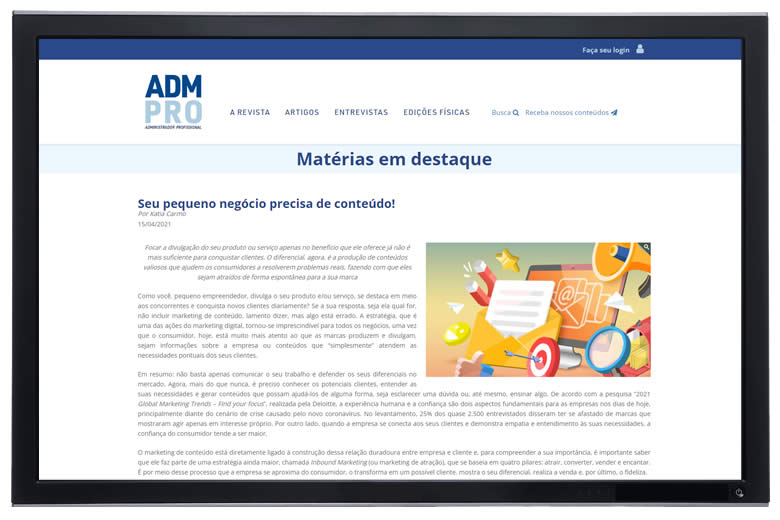ADM PRO: Content and Small Business
Your small business needs content!
(Katia Carmo)

Focusing the promotion of your product or service only on the benefit it offers is no longer enough to win customers. The differential now is the production of valuable content that helps consumers solve real problems, causing them to be spontaneously attracted to your brand.
How do you, as a small entrepreneur, advertise your product and/or service, stand out among your competitors, and win new customers on a daily basis? If your answer, whatever it is, does not include content marketing, I’m sorry to say, but something is wrong. The strategy, which is one of the actions of digital marketing, has become essential for all businesses, since the consumer today is much more attentive to what brands produce and disseminate, whether it is information about the company or content that “simply” meets the specific needs of its customers.
In short: it is not enough just to communicate your work and defend your differentials in the market. Now, more than ever, you need to know your potential customers, understand their needs, and generate content that can help them in some way, either by clarifying a doubt or even by teaching them something. According to the survey “2021 Global Marketing Trends – Find your focus”, conducted by Deloitte, the human experience and trust are two fundamental aspects for companies nowadays, especially in the face of the crisis scenario caused by the new coronavirus. In the survey, 25% of the almost 2,500 respondents said they have moved away from brands that have shown to act only in their own interest. On the other hand, when a company connects with its customers and shows empathy and understanding of their needs, consumer trust tends to be higher.
Content marketing is directly linked to building this lasting relationship between company and customer, and to understand its importance it is important to know that it is part of an even larger strategy called Inbound Marketing (or attraction marketing), which is based on four pillars: attract, convert, sell, and delight. It is through this process that the company gets closer to the consumer, turns him into a potential customer, shows its differential, makes the sale, and, finally, builds loyalty.
The persona importance
A successful content marketing strategy starts with a simple step: knowing your customers. Only then will it be possible to produce content that is, in fact, relevant to this audience. At this moment, the definition of a persona, that is, the creation of a fictitious profile, with habits, pains, and desires that represent the ideal consumer of your company, is fundamental. It is necessary to understand that this character is very different from identifying a target audience, which only selects a generic group of people with common characteristics.
Therefore, building a persona is something much more complex and needs to start from real information, collected and analyzed based on data from existing customers. “In content marketing, we use the concept of persona a lot because creating strategies directed to a person, even a fictional one, allows us to create more valuable content for that person in several aspects, instead of limiting ourselves to talking only about our company. Understanding to whom you are directing your information and what your potential client is searching for greatly increases the chances of your material being relevant to your audience”, explains Vitor Peçanha, cofounder of Rock Content, a company focused on services and creation of marketing products.
How to make it real?
After getting to know your client and defining a persona it is time to start your action plan. Before, however, you need to know that content marketing is a medium to long-term process that depends on dedication, patience, and continuous work. “The results of a good strategy are long-lasting, but they need time. Many people end up giving up because they don’t see results in two months, which is completely normal. If you have made a good plan, take the time to get your hands dirty and study a lot, see what your competitors are doing, get up to date,” advises Peçanha.
The specialist also points out that the beginning does not necessarily have to happen in a complex way, and that the most important thing is to create interesting content in a channel that reaches the desired audience. “Try to create authentic content, which will really solve a problem for your persona and add value for those who are consuming your information,” he explains.
Who also defends a more quality-focused start is Fabrício Saad, MBA professor for the digital and innovation themes at the Escola Superior de Propaganda e Marketing – ESPM and CMO at MZF4. For him, the small company must adapt to its reality and production capacity. “There is no point, for example, in setting up company profiles in five social networks and not being able to handle one! Content in social media presupposes something alive and up-to-date at all times, and for the end customer, no matter the size of your company – he will always expect something relevant, true, and purposeful. That’s important to always keep in mind,” he says.

Fabrício Saad, MZF4’s CMO.
Diversifying the media and content
But after all, what kind of content do you need to create to attract potential customers? Diversification, according to specialists, is fundamental for a successful strategy. Creating posts on blogs and social networks, as well as videos, infographics, and other visual resources is important to reach the greatest number of people. “The digital consumer expects a lot from brands. They want to be surprised. The idea behind content experiences is to think that your audience will interact with you at different moments along the buying journey and that they are all part of the same experience. So it is the role of those who work with marketing to create a flow of rich, relevant content that engages and interacts with the audience throughout this journey. And diversification is part of that. Creating valuable content is creating experiences,” argues Peçanha.
This does not mean, however, that this production has to happen every day, after all, most small businesses have an extremely lean marketing team. Therefore, according to Saad, it is always better to define your strategy based on quality and not quantity. “The periodicity should be such that you can publish and provide your network with relevant content. There is no need for something daily. In many segments, weekly is enough, and the maintenance of the network with reposts of other content, responses to manifestations and interactions, etc.
How to measure the results?
Keeping indicators that enable the monitoring of actions is one of the key points to know if the adopted planning has generated the expected results. It is also through these indicators that you can measure the engagement of your audience and adjust what is necessary for your strategy. “Taking into account some basic indicators, such as the number of hits on the page, the number of weekly followers the page is gaining, among other things, tells you a lot initially so that, in the near future, you can see this in increased leads and sales conversion, which is what we all hope to achieve in the end,” Saad concludes.
Stay tuned!
Inbound Marketing – a marketing strategy that seeks to capture people’s interest in a non-invasive or interruptive way.
Landing page – any page that acts as an audience filter and a gateway for visitors to a website or other page. In digital marketing, it usually has a specific conversion goal, such as sales or lead generation.
Leads – people who have shown interest in purchasing your company’s product or service by filling out online forms with their contact information. A lead is a potential customer.
Conversion – occurs when the user performs a desired action, such as filling out your form in order to receive free content. However, a definite conversion is when the consumer purchases your product.

Published in ADM PRO website on April 15th, 2021:
crasp.gov.br/admpro/site/materias-em-destaque/seu-pequeno-negocio-precisa-de-conteudo


